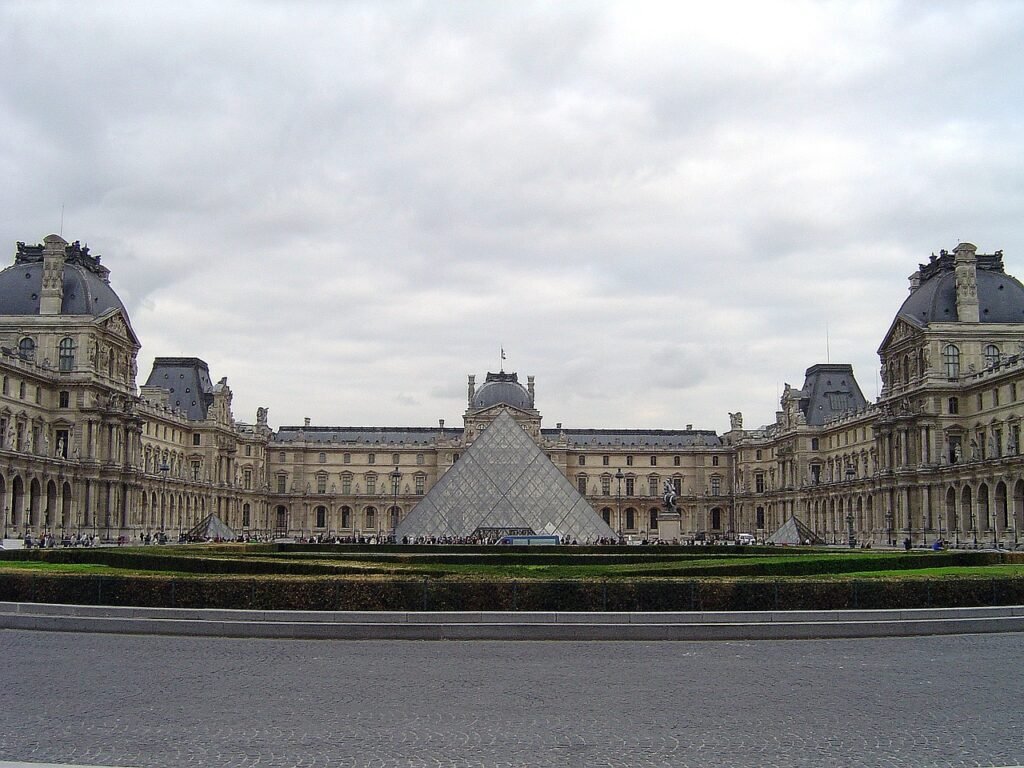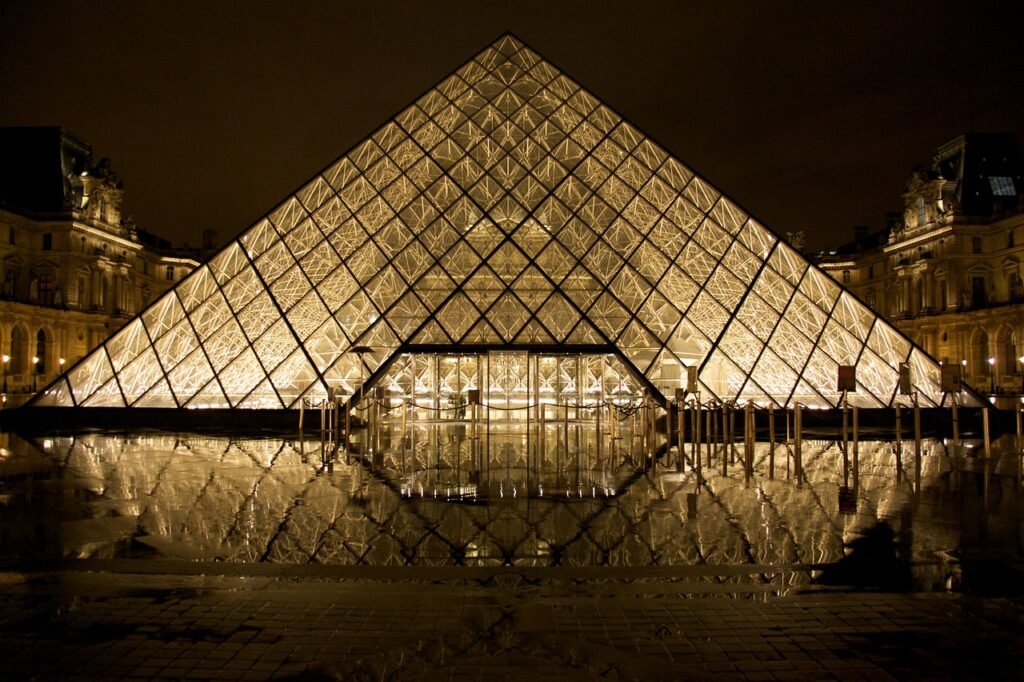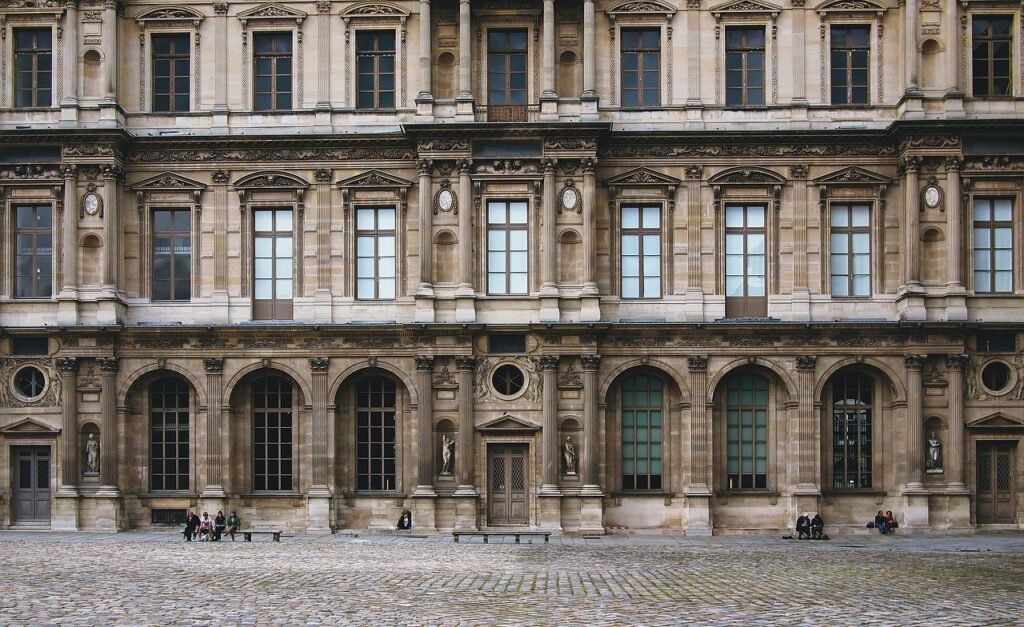The Louvre Pyramid is located in the city of Paris. The city of Paris is popular among the romantics and those who seek solace in arts. The Eiffel Tower is not the only tourist attraction when talking about Paris.
The Louvre stands as a symbol of modern architecture and an iconic monument. It gracefully blends into the romantic allure of the city of Paris. The museum’s courtyards and gardens, including the charming Tuileries Garden, offer serene spots for quiet reflection amidst the bustling city.
The History of Louvre Pyramid Paris

The Louvre dates back to the 12th century when King Phillipe Auguste laid its foundation as a fortress. Over the centuries, it transformed from a guarded bastion to a Renaissance palace. It ultimately became the world’s iconic museum in 1793.
As you wander through its grand halls, you walk in the footsteps of monarchs and visionaries who shaped its legacy.
I.M. Pei’s Journey of Designing the Iconic Louvre Pyramid
I.M. Pei was a Chinese American architect well known for blending modernist design with historical and cultural contexts. His design philosophy was inclined towards geometrical shapes and incorporating natural light into his designs.
I.M. Pei faced a number of challenges and setbacks in his journey. One of the most notable was during his work on the Louvre, where he faced significant controversy. In 1983, French President François Mitterrand appointed him to transform the Louvre. This was a groundbreaking moment as Pei became the first foreign architect chosen for such a prestigious renovation.
I.M Pei’s concept was revolutionary, proposing the construction of a gigantic glass and steel mesh pyramid in the Cour Napoléon courtyard to serve as the museum’s main entrance. Traditionalists, historians and the public fiercely opposed and expressed skepticism toward his out-of-the-box idea. Many believed modernist pyramid would clash with the classical identity of the historical palace, degrading the centuries-old cultural landmark. Pei endured intense scrutiny and criticism, with questions raised about his understanding of French heritage.
I.M Pei’s Thoughtful Design Approach
Unshaken, I.M Pei embarked on a thorough study of the Louvre, its architectural history, and its cultural significance. He made many private visits to Paris, observing the museum’s ambience, context, and structure. His goal was to propose a design solution that would not only honor the Louvre’s predetermined legacy but also address the overlooked practical issues. Pei’s dedication to a conscious design was evident in his careful and smart consideration of materials, proportions, and spatial relationships.
Another noteworthy aspect of Pei’s journey was his collaboration with local artisans and engineers, ensuring that the pyramid’s construction adhered to the highest standards of craftsmanship.
Despite the initial resistance, Pei’s hard work paid off. The renovation design was approved and completed in 1989 and opened to the public. It soon
became an iconic symbol, blending modernity with history in a harmonious and visually striking way.
The Art Collection
The Louvre’s valued collections comprise about 38,000 masterpieces, spanning millennia and offering a mesmerizing journey through civilization’s progress.
The museum’s eight departments—Near Eastern Antiquities, Egyptian Antiquities, Greek, Etruscan, and Roman Antiquities, Islamic Art, Sculptures, Decorative Arts, Paintings, and Prints and Drawings—showcase the diversity and richness of international cultural heritage.
The famous “Mona Lisa’s smile” painting is the highlight and one of the most treasured art pieces at the museum.
Equally captivating is the Venus de Milo, a stunning statue of the Greek goddess of love and beauty, epitomizing classical elegance and grace.
The Pyramid of the modern times

In 1981, newly elected French president François Mitterrand launched a campaign to renovate cultural institutions in France, sparking the ambitious Louvre project. The Chinese American architect, I.M. Pei, was commissioned in 1983 to work on the renovation of the museum.
The project wound up in 1989. I.M. Pei’s renovation redesigned Cour Napoleon, the main court of the Louvre, in order to alleviate the congestion from the thousands of daily visitors.
A new grand entrance has been provided, offering a convenient, central lobby space that is separate from the galleries. It is designated as the focal point of the museum and maintains a balanced visual hierarchy throughout the entire structure.
The Architecture Inspiration of Louvre Pyramid Paris

The architecture of the Louvre is designed to the proportion of the great Pyramid of Giza; the pyramid harmonizes with the French Renaissance style of the museum, enhancing its beauty and paying homage to its architectural details. It symbolizes the dynamic relationship between the museum’s historic architecture and modern innovation.
The Louvre includes a large glass and steel pyramid surrounded by three smaller triangles that illuminate the space below Cour Napoleon. The design of the exterior allows natural light to seep into the underground entrance area, creating a welcoming and warm ambiance at the entrance. The structure is the epitome of modern minimalist design, symbolizing the fusion of historical and contemporary design elements.
The sleek and transparent glazing adorns the façade of the Louvre, creating a stunning visual juxtaposition. The pyramid form represents stability and timelessness, a metaphor for the classic art collection it showcases.
I.M Pei’s design included a new underground space for galleries, storage, and preservation laboratories, as well as a connection between the museum’s wings. It provided additional room to expand the gallery and exhibit more art collections.
Please also read: Best Holiday Destinations for Families 2025 – Perky Pulse Website Travel
Planning Your Visit
The Louvre is located on the Right Bank of the Seine, in the 1st arrondissement of Paris. It’s easily accessible by public transport, with the Palais Royal-Musée du Louvre metro station right at its doorstep. To avoid the crowds, consider booking your tickets online in advance and arriving early in the morning or later in the evening.
For an unforgettable and memorable experience, visit the Louvre at night. The museum is open until 9:45 PM on Wednesdays and Fridays, allowing tourists and art lovers to explore its treasures under the soft glow of evening lights. The illuminated pyramid and the softly lit interiors create an ethereal ambiance, perfect for a romantic rendezvous.

